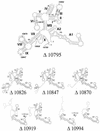Spontaneous and engineered deletions in the 3' noncoding region of tick-borne encephalitis virus: construction of highly attenuated mutants of a flavivirus
- PMID: 9499069
- PMCID: PMC109508
- DOI: 10.1128/JVI.72.3.2132-2140.1998
Spontaneous and engineered deletions in the 3' noncoding region of tick-borne encephalitis virus: construction of highly attenuated mutants of a flavivirus
Abstract
The flavivirus genome is a positive-strand RNA molecule containing a single long open reading frame flanked by noncoding regions (NCR) that mediate crucial processes of the viral life cycle. The 3' NCR of tick-borne encephalitis (TBE) virus can be divided into a variable region that is highly heterogeneous in length among strains of TBE virus and in certain cases includes an internal poly(A) tract and a 3'-terminal conserved core element that is believed to fold as a whole into a well-defined secondary structure. We have now investigated the genetic stability of the TBE virus 3' NCR and its influence on viral growth properties and virulence. We observed spontaneous deletions in the variable region during growth of TBE virus in cell culture and in mice. These deletions varied in size and location but always included the internal poly(A) element of the TBE virus 3' NCR and never extended into the conserved 3'-terminal core element. Subsequently, we constructed specific deletion mutants by using infectious cDNA clones with the entire variable region and increasing segments of the core element removed. A virus mutant lacking the entire variable region was indistinguishable from wild-type virus with respect to cell culture growth properties and virulence in the mouse model. In contrast, even small extensions of the deletion into the core element led to significant biological effects. Deletions extending to nucleotides 10826, 10847, and 10870 caused distinct attenuation in mice without measurable reduction of cell culture growth properties, which, however, were significantly restricted when the deletion was extended to nucleotide 10919. An even larger deletion (to nucleotide 10994) abolished viral viability. In spite of their high degree of attenuation, these mutants efficiently induced protective immune responses even at low inoculation doses. Thus, 3'-NCR deletions represent a useful technique for achieving stable attenuation of flaviviruses that can be included in the rational design of novel flavivirus live vaccines.
Figures



Similar articles
-
Infectious cDNA clone of attenuated Langat tick-borne flavivirus (strain E5) and a 3' deletion mutant constructed from it exhibit decreased neuroinvasiveness in immunodeficient mice.Virology. 2001 Apr 10;282(2):288-300. doi: 10.1006/viro.2001.0846. Virology. 2001. PMID: 11289811
-
The flavivirus 3'-noncoding region: extensive size heterogeneity independent of evolutionary relationships among strains of tick-borne encephalitis virus.Virology. 1995 Oct 20;213(1):169-78. doi: 10.1006/viro.1995.1557. Virology. 1995. PMID: 7483260
-
Biological consequences of deletions within the 3'-untranslated region of flaviviruses may be due to rearrangements of RNA secondary structure.Virus Res. 1999 Nov;64(2):107-23. doi: 10.1016/s0168-1702(99)00079-9. Virus Res. 1999. PMID: 10518708
-
Chimeric flaviviruses: novel vaccines against dengue fever, tick-borne encephalitis, and Japanese encephalitis.Adv Virus Res. 2003;61:469-509. doi: 10.1016/s0065-3527(03)61013-4. Adv Virus Res. 2003. PMID: 14714441 Review.
-
The molecular biology of tick-borne encephalitis virus. Review article.APMIS. 1993 Oct;101(10):735-45. doi: 10.1111/j.1699-0463.1993.tb00174.x. APMIS. 1993. PMID: 8267950 Review.
Cited by
-
Neuroadapted yellow fever virus 17D: genetic and biological characterization of a highly mouse-neurovirulent virus and its infectious molecular clone.J Virol. 2001 Nov;75(22):10912-22. doi: 10.1128/JVI.75.22.10912-10922.2001. J Virol. 2001. PMID: 11602731 Free PMC article.
-
Functional RNA elements in the dengue virus genome.Viruses. 2011 Sep;3(9):1739-56. doi: 10.3390/v3091739. Epub 2011 Sep 15. Viruses. 2011. PMID: 21994804 Free PMC article. Review.
-
In vitro resistance selection and in vivo efficacy of morpholino oligomers against West Nile virus.Antimicrob Agents Chemother. 2007 Jul;51(7):2470-82. doi: 10.1128/AAC.00069-07. Epub 2007 May 7. Antimicrob Agents Chemother. 2007. PMID: 17485503 Free PMC article.
-
A Non-Replicative Role of the 3' Terminal Sequence of the Dengue Virus Genome in Membranous Replication Organelle Formation.Cell Rep. 2020 Jul 7;32(1):107859. doi: 10.1016/j.celrep.2020.107859. Cell Rep. 2020. PMID: 32640225 Free PMC article.
-
Tick-Borne Encephalitis Virus: A Quest for Better Vaccines against a Virus on the Rise.Vaccines (Basel). 2020 Aug 12;8(3):451. doi: 10.3390/vaccines8030451. Vaccines (Basel). 2020. PMID: 32806696 Free PMC article. Review.
References
-
- Cahour A, Pletnev A, Vazeille-Falcoz M, Rosen L, Lai C-J. Growth-restricted dengue virus mutants containing deletions in the 5′ noncoding region of the RNA genome. Virology. 1995;207:68–76. - PubMed
-
- Chambers T J, Hahn C S, Galler R, Rice C M. Flavivirus genome organization, expression, and replication. Annu Rev Microbiol. 1990;44:649–688. - PubMed
-
- Gritsun T S, Venugopal K, de A. Zanotto P M, Mikhailov M V, Sall A A, Holmes E C, Polkinghorne I, Frolova T V, Pogodina V V, Lashkevich V A, Gould E A. Complete sequence of two tick-borne flaviviruses isolated from Siberia and the UK: analysis and significance of the 5′ and 3′-UTRs. Virus Res. 1997;49:27–39. - PubMed
MeSH terms
Substances
LinkOut - more resources
Full Text Sources
Other Literature Sources

